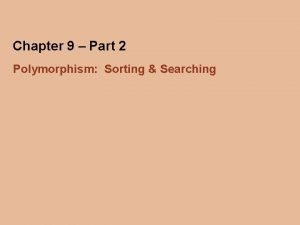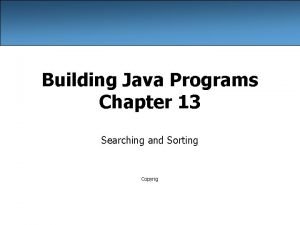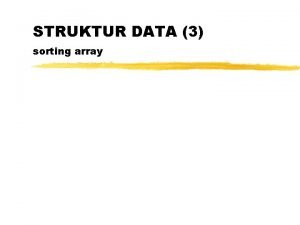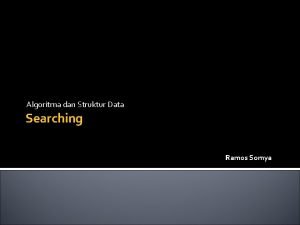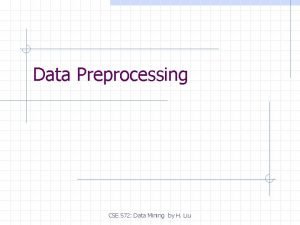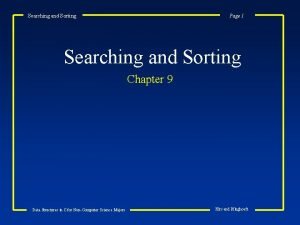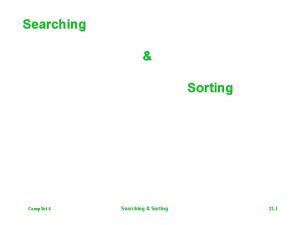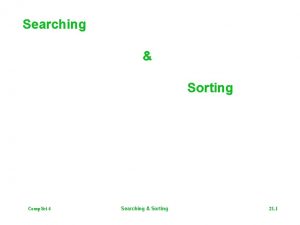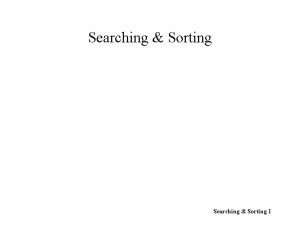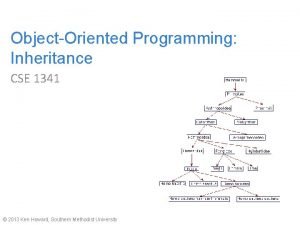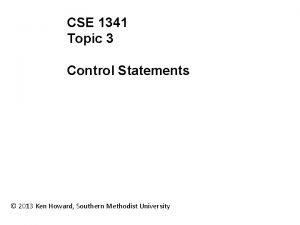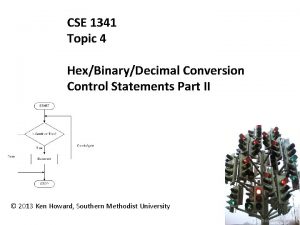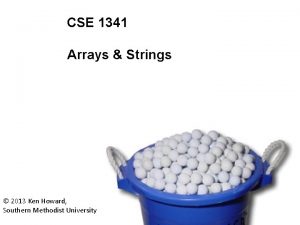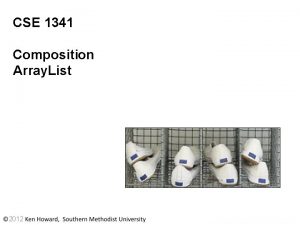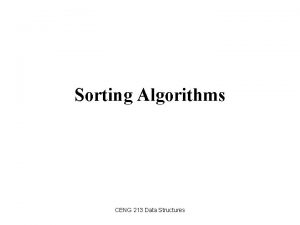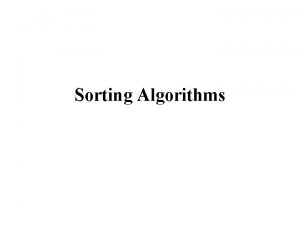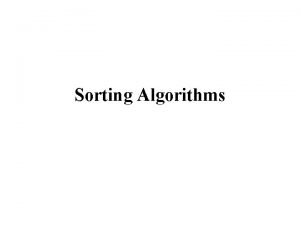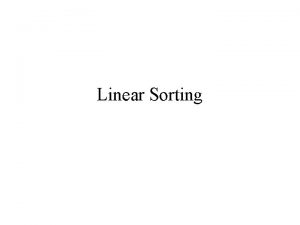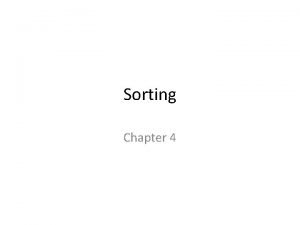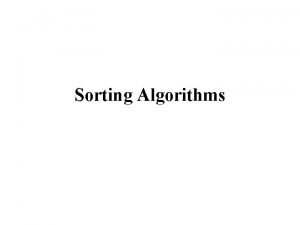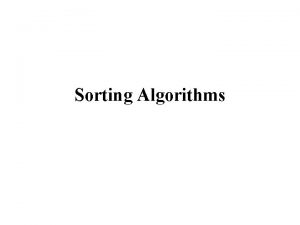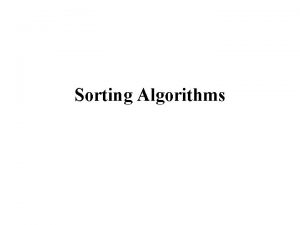CSE 1341 Sorting Searching Searching Sorting Searching data




















![public class Selection. Sort{ public static void selection_srt(int array[], int n) public static void public class Selection. Sort{ public static void selection_srt(int array[], int n) public static void](https://slidetodoc.com/presentation_image_h2/43da86e6a4e13a58c4cd7d8e5b9ebe25/image-21.jpg)

![public class Bubble. Sort { public static void bubble_srt( int a[], int n ) public class Bubble. Sort { public static void bubble_srt( int a[], int n )](https://slidetodoc.com/presentation_image_h2/43da86e6a4e13a58c4cd7d8e5b9ebe25/image-23.jpg)
- Slides: 23

CSE 1341 Sorting & Searching

Searching & Sorting • Searching data involves determining whether a value (referred to as the search key) is present in the data and, if so, finding its location. • Sorting places data in ascending or descending order, based on one or more sort keys.

Linear Search • The linear search algorithm searches each element in an array sequentially. – If the search key does not match an element in the array, the algorithm tests each element, and when the end of the array is reached, informs the user that the search key is not present. – If the search key is in the array, the algorithm tests each element until it finds one that matches the search key and returns the index of that element. • If there are duplicate values in the array, linear search returns the index of the first element in the array that matches the search key.

4

Arrays static method to. String returna a String representation of an array. 5

6

7

8

Searching Efficiency • What is the maximum number of comparisons that is required when doing a linear search? • What if an array contained one million elements? What’s the most efficient way to look up a word in the dictionary?

Binary Search • The binary search algorithm is more efficient than linear search, but it requires that the array be sorted. – The first iteration tests the middle element in the array. If this matches the search key, the algorithm ends. – If the search key is less than the middle element, the algorithm continues with only the first half of the array. – If the search key is greater than the middle element, the algorithm continues with only the second half. – Each iteration tests the middle value of the remaining portion of the array. – If the search key does not match the element, the algorithm eliminates half of the remaining elements. – The algorithm ends by either finding an element that matches the search key or reducing the sub-array to zero size.


Arrays static method sorts the elements of an array in ascending order.






How Efficient is Binary Search? • Maximum comparisons with 10 elements… How many times can you divide a number by 2? 1, 000 elements would require max of 10 comparisons 210 = 1024 OR log 2(1, 000) ≈ 10 1, 000 elements would require max of 20 comparisons 220 = 1, 048, 576 OR log 2(1, 000) ≈ 20

Sorting Algorithms • Sorting data (i. e. , placing the data into some particular order, such as ascending or descending) is one of the most important computing applications. • An important item to understand about sorting is that the end result—the sorted array—will be the same no matter which algorithm you use to sort the array. • The choice of algorithm affects only the run time and memory use of the program.

Selection Sort Find the smallest value and swap places with the first element Repeat for 2 -n, 3 -n, 4 -n, …. n-n
![public class Selection Sort public static void selectionsrtint array int n public static void public class Selection. Sort{ public static void selection_srt(int array[], int n) public static void](https://slidetodoc.com/presentation_image_h2/43da86e6a4e13a58c4cd7d8e5b9ebe25/image-21.jpg)
public class Selection. Sort{ public static void selection_srt(int array[], int n) public static void main(String a[]) { { for(int x=0; x<n; x++) int i; { int array[] = {12, 9, 4, 99, 120, 1, 3, 10}; int index_of_min = x; System. out. println(" Selection Sort n"); for(int y=x; y<n; y++) System. out. println("Values Before the sort: n"); { if(array[index_of_min]>array[y]) for(i = 0; i < array. length; i++) index_of_min = y; System. out. print( array[i]+" "); } //end inner for loop System. out. println(); int temp = array[x]; selection_srt(array, array. length); array[x] = array[index_of_min]; System. out. print("Values after the sort: n"); array[index_of_min] = temp; for(i = 0; i <array. length; i++) } //end out er for loop System. out. print(array[i]+" "); } //end method selection_srt System. out. println(); } //end main }//end class Selection. Sort

Bubble Sort Repeat n-1 times
![public class Bubble Sort public static void bubblesrt int a int n public class Bubble. Sort { public static void bubble_srt( int a[], int n )](https://slidetodoc.com/presentation_image_h2/43da86e6a4e13a58c4cd7d8e5b9ebe25/image-23.jpg)
public class Bubble. Sort { public static void bubble_srt( int a[], int n ) public static void main(String a[]){ { int i; int i, j, t=0; int array[] = {12, 9, 4, 99, 120, 1, 3, 10}; for(i = 0; i < n; i++) System. out. println("Values Before the sort: n"); { for(i = 0; i < array. length; i++) for(j = 1; j < (n-i); j++) System. out. print( array[i]+" "); { System. out. println(); if(a[j-1] > a[j]) { t = a[j-1]; bubble_srt(array, array. length); a[j-1]=a[j]; a[j]=t; System. out. print("Values after the sort: n"); } //end if } //end inner for loop for(i = 0; i <array. length; i++) } //end outer for loop System. out. print(array[i]+" "); } //end method bubble_srt System. out. println(); }//end class Bubble. Sort }
 Pengertian searching dalam struktur data
Pengertian searching dalam struktur data Difference between external and internal sorting
Difference between external and internal sorting Pengertian searching dalam struktur data
Pengertian searching dalam struktur data Searching and sorting arrays in c++
Searching and sorting arrays in c++ Big o java
Big o java Searching and sorting in java
Searching and sorting in java Big o java
Big o java Searching and sorting in java
Searching and sorting in java Apa tujuan dari hasil proses pengurutan data
Apa tujuan dari hasil proses pengurutan data Orale charakterstruktur
Orale charakterstruktur Tujuan melakukan sorting data di dokumen adalah
Tujuan melakukan sorting data di dokumen adalah Metode sorting yang mirip dengan cara mengurutkan kartu
Metode sorting yang mirip dengan cara mengurutkan kartu Struktur data searching
Struktur data searching Cse 572 data mining
Cse 572 data mining Cse 572
Cse 572 Lego sorting machine instructions
Lego sorting machine instructions Dn
Dn Evaporating mixtures
Evaporating mixtures Sorting sedimentary rocks
Sorting sedimentary rocks The principle of sorting classifier is/are
The principle of sorting classifier is/are Grain size sorting formula
Grain size sorting formula Sediment sorting
Sediment sorting Inplace sorting
Inplace sorting Harry potter outline
Harry potter outline





